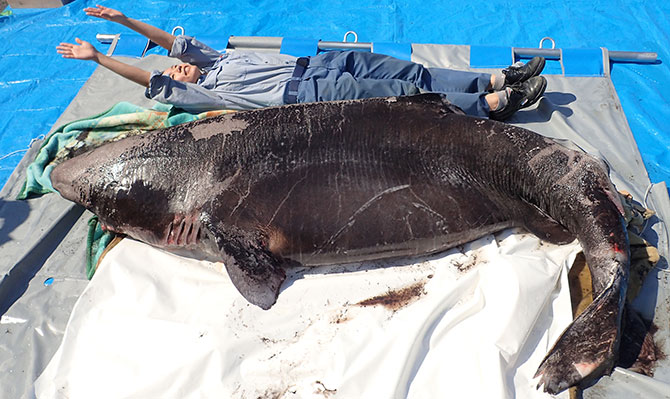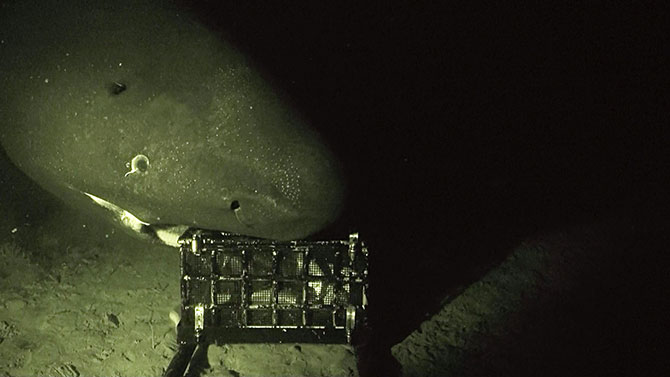Press Releases

JAMSTEC
World's First Measurements of Pacific Sleeper Shark Swimming Speed and Population Density
Giant Deep-Sea Sharks of Suruga Bay are the World's Slowest Swimmers
1. Key points
- ◆
- In this first ever measurement of the swimming speed of the Pacific sleeper shark, one of the largest species in the deep sea of Suruga Bay, the speed was shown to be comparable to that of the Greenland shark, known as the slowest swimming fish, adjusted for size.
- ◆
- Previously, a decrease in metabolism due to the low temperature of the Greenland shark's habitat has been suggested as the cause for its slow swimming speed; however, the temperature and other factors in the survey area studied here suggest that this could be explained by the Visual Interaction Hypothesis.
- ◆
- We developed a new method for calculating the population density of top predators/scavengers in deep sea and estimated that of the Pacific sleeper shark in Suruga Bay at approximately 1,150 individuals.
2. Overview
Principal Researcher Yoshihiro Fujiwara and colleagues at the Research Institute for Global Change of the Japan Agency for Marine-Earth Science and Technology (JAMSTEC) have determined the swimming speed of one of the largest deep-sea shark species in Suruga Bay, the Pacific sleeper shark (Somniosus pacificus) (Figure 1), in a bait camera survey conducted in 2016.
A female Pacific sleeper shark, approximately 3 m long, was recorded on two bait cameras placed at a depth of 600 m in Suruga Bay. This female shark had the following visual characteristics: fishing line wrapped around the snout, two missing gill covers on the left side, and parasitic copepods attached to both eyes. The individual initially appeared in front of the first camera, before being recorded by the second camera at a later time, and finally appeared in front of the first camera again. The distance between the two cameras was 436 m. Based on the swimming speed estimated from the time of travel between the cameras, the average speed relative to the ground and water was found to be 21 cm/s and 25 cm/s, respectively, for the first and second camera. It was thereby found that the Pacific sleeper shark is among the slowest swimming fishes in the world, alongside the Greenland shark, the slowest known fish that falls in the similar weight group with a comparable swimming speed of 22–34 cm/s. The slow swimming speed of the Greenland shark was thought to be related to its low metabolic rate owing to the very low temperature of its habitat (2 °C or less). However, the temperature of the habitat of the Pacific sleeper shark recorded in this study was relatively high, at approximately 5 °C, demonstrating that the slow swimming speed of the Pacific sleeper shark was not caused by low water temperature. The Visual Interaction Hypothesis has been proposed in relation to the depth-related decrease in metabolism reported in deep-sea organisms with vision, and we found that the slow swimming speed of the Pacific sleeper shark was consistent with this hypothesis.
In the present study, we also proposed a new method for calculating the population density of deep-sea organisms using bait camera footage and data on current direction and velocity. An estimated 1,150 Pacific sleeper sharks live at depths of 500–1,000 m in Suruga Bay.
These results will be published on 18th May 2021 (Japan time) in the Journal of the Marine Biological Association of the United Kingdom.
*Corresponding author
- Research Institute for Global Change (RIGC), Japan Agency for Marine-Earth Science and Technology (JAMSTEC)
a

b

- Figure 1.
a: - 2.8-m Pacific sleeper shark captured in August in 2016 at a depth of approximately 500 m in Suruga Bay (this is a different individual than the one recorded by the bait camera).
- b:
- An image of a Pacific sleeper shark biting on the bait cage of a bait camera.
Contacts
- (For this study)
- Yoshihiro Fujiwara, Principal Researcher, Research Institute for Global Change (RIGC), Marine Biodiversity and Environmental Assessment Research Center (BioEnv), Deep-Sea Biodiversity Research Group (DeepBio), JAMSTEC
- (For press release)
- Public Relations Section, Marine Science and Technology Strategy Department, JAMSTEC